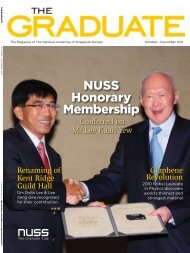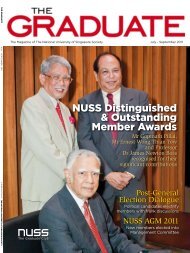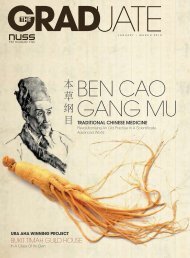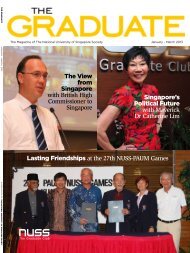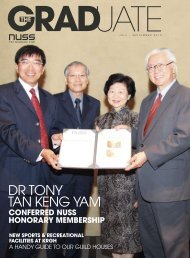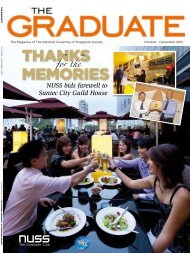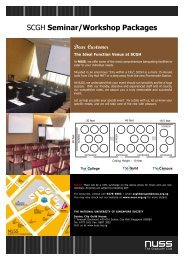Building Lifelong Relationships - NUSS
Building Lifelong Relationships - NUSS
Building Lifelong Relationships - NUSS
You also want an ePaper? Increase the reach of your titles
YUMPU automatically turns print PDFs into web optimized ePapers that Google loves.
PG nuss<br />
annual report 2006<br />
5.5 Mr Tay replied that based on the current financial position of <strong>NUSS</strong>, the MC would not be able to consider this matter.<br />
However, if <strong>NUSS</strong>’ finances were to improve in future due to increased membership and revenue, then future committees<br />
could consider this matter as it appeared to enjoy the support of many members present at the meeting.<br />
5.6 Mr Lai Kim Seng (Mr Lai) (L2353H) added that while there would be a loss of some facilities at Kent Ridge Guild House<br />
during the upgrading period, the MC had made alternative arrangements for members to use facilities in the vicinity, such<br />
as at the NUS Sports & Recreation Centre and the new NUS High School. In addition, Singapore Polytechnic Graduates’<br />
Guild would allow members to use their facilities under a reciprocal arrangement.<br />
5.7 Mr Low Siew Aik (Mr Low) (L4882A) enquired on the implementation date for the transferability of membership.<br />
5.8 In reply, Mr Mohan stated that the proposed constitutional amendments after approval by the House would need to be<br />
submitted to the Registrar of Societies for approval. Upon approval, they would become effective on payment of the<br />
requisite fees to the Registrar of Societies.<br />
5.9 Mr Low commented that if he sold his transferable golf club membership at market price to a buyer, the buyer would not<br />
need to pay any transfer fee. He could not reconcile the need to pay a transfer fee for a transferable membership.<br />
5.10 Mr Tay clarified that there would be a base transfer fee of $2,000. At that price, it would effectively mean that from March<br />
2006 to March 2007, no member would be able to sell his or her membership. Beyond March 2007 and with an entrance<br />
fee of $3,000, there would also be very little incentive for members to sell their transferable membership in the open<br />
market.<br />
Mr Tay said that the intention was to increase the membership to as close as the 15,000 target as possible by March 2007.<br />
And beyond March 2007, the focus would be on the new graduates who would join at $2,000 and, as such, they would<br />
not buy a membership from the open market. On the other hand, other graduates who did not join within three years of<br />
graduation and who wished to join would try to buy their membership from the open market at a lower price.<br />
Mr Tay emphasised that the entrance fee was currently capped at $5,000 because <strong>NUSS</strong> would like to welcome as many<br />
graduates as possible into its fold. He added that while the ceiling could be raised in future, it should not go beyond say<br />
$50,000, which would make <strong>NUSS</strong> exclusive such that other than fresh graduates, other eligible graduates who did not join<br />
earlier would find it difficult to join and be excluded.<br />
In reply to a further question from Mr Low, Mr Tay conceded that the transferable membership, under the current cap of<br />
$5,000, would unlikely be sold for more than $2,000 after accounting for the $2,000 transfer fee and broker’s commission.<br />
5.11 Mr Ernest Tan Kwan Boon (Mr Tan) (T3070G) was worried about the declining membership which was not in sync with the<br />
growing graduate population and the improving economy in Singapore. He added that <strong>NUSS</strong> should not position itself in<br />
the same class as some clubs and that it was important to evaluate other solutions and to focus on improving the general<br />
membership.<br />
5.12 Mr Mohan thanked Mr Tan for his comments and noted that while the graduate population was growing, there was<br />
competition from other clubs and societies for membership. He emphasised that members should actively participate in<br />
the membership drive and that if every member could each recruit one new member, the impact would be fantastic and<br />
would go a long way to help solve <strong>NUSS</strong>’ current problems.<br />
5.13 Dr Francis Pavri (Dr Pavri) (P2086A) was concerned that there could be some new graduate members who had no intention<br />
to remain in <strong>NUSS</strong> but who joined because they could sell their $2,000 transferable membership later in the open market<br />
for a profit.<br />
5.14 Mr Tay reiterated that transferability was not intended to allow members to profiteer from selling their membership on the<br />
open market. As mentioned earlier, no one would buy a membership for more than $5,000 and after taking into account<br />
the transfer fee and broker’s commission, the maximum amount any member could make would be less than $1,000,<br />
which would not be attractive. In any case, transferability would have helped to attract one more member for <strong>NUSS</strong>.<br />
5.15 Dr Pavri highlighted that members who were 50 years and above comprised 20% of the membership while those<br />
below 29 years comprised only 2%. He added that many undergraduates were probably not aware of the existence and<br />
objectives of <strong>NUSS</strong>. He asked whether there were any plans to tap into this important segment.



